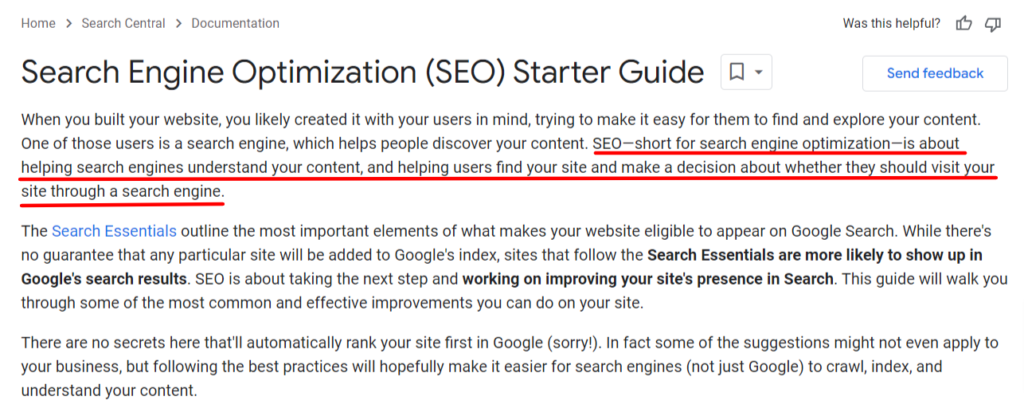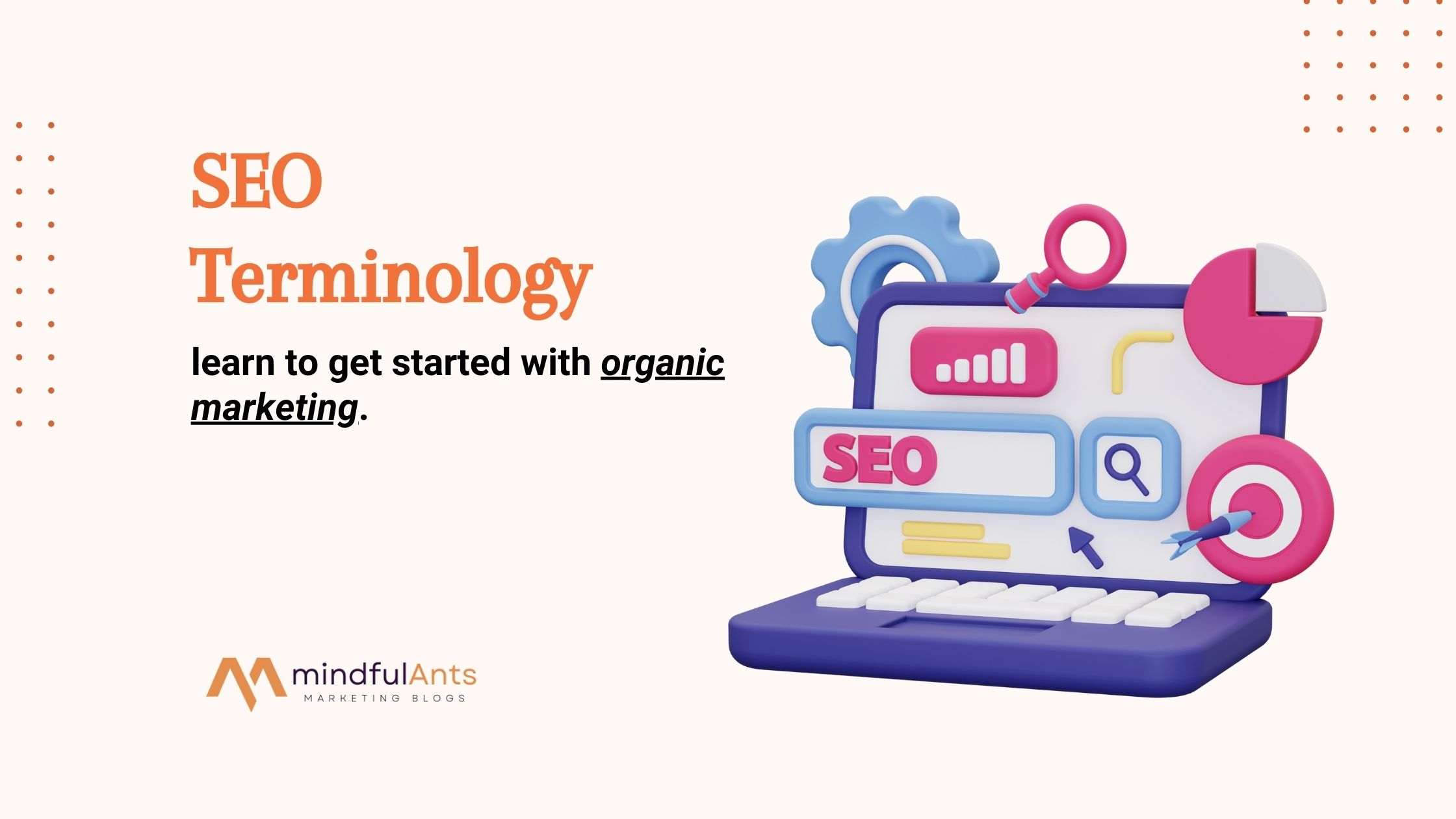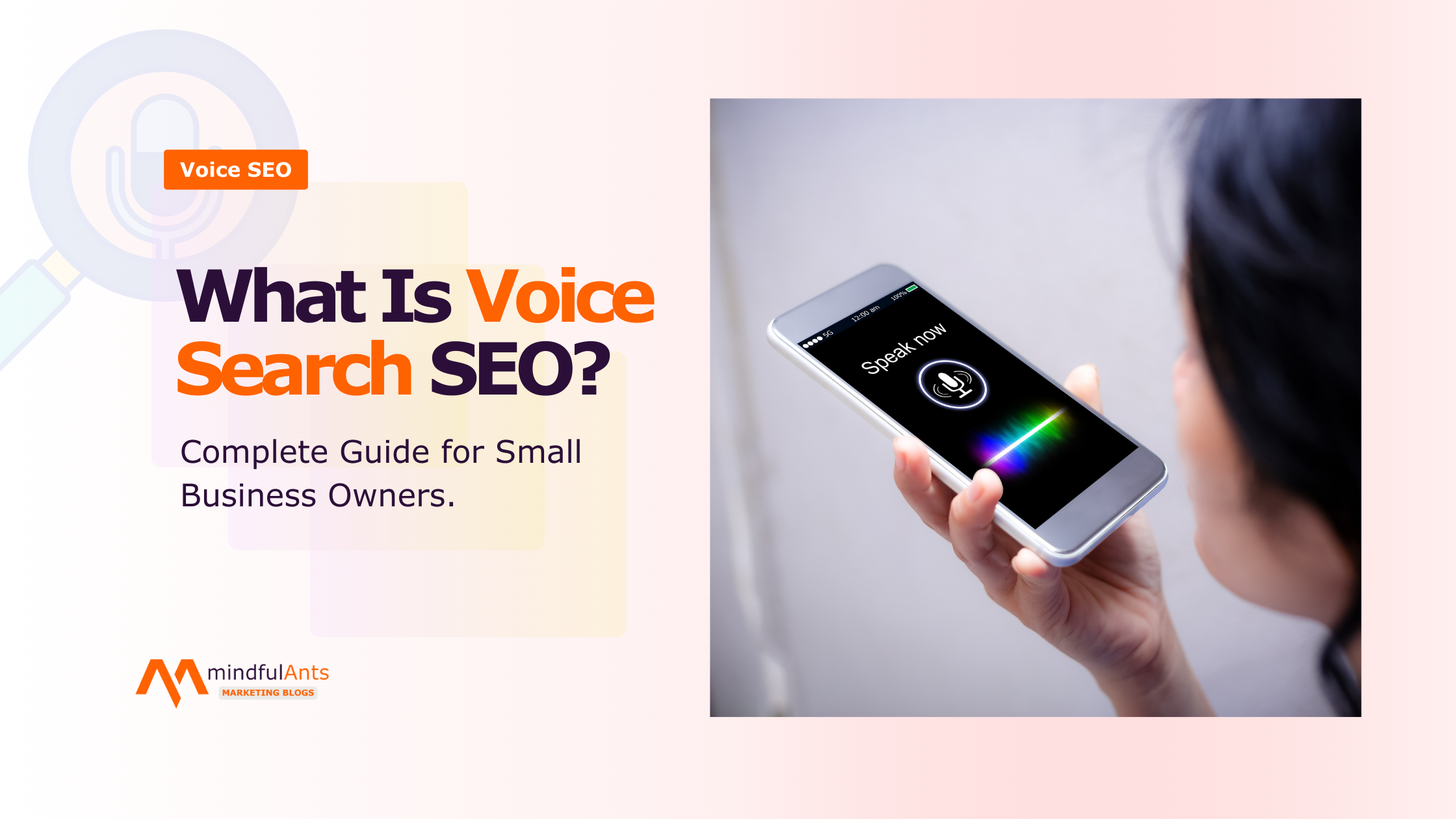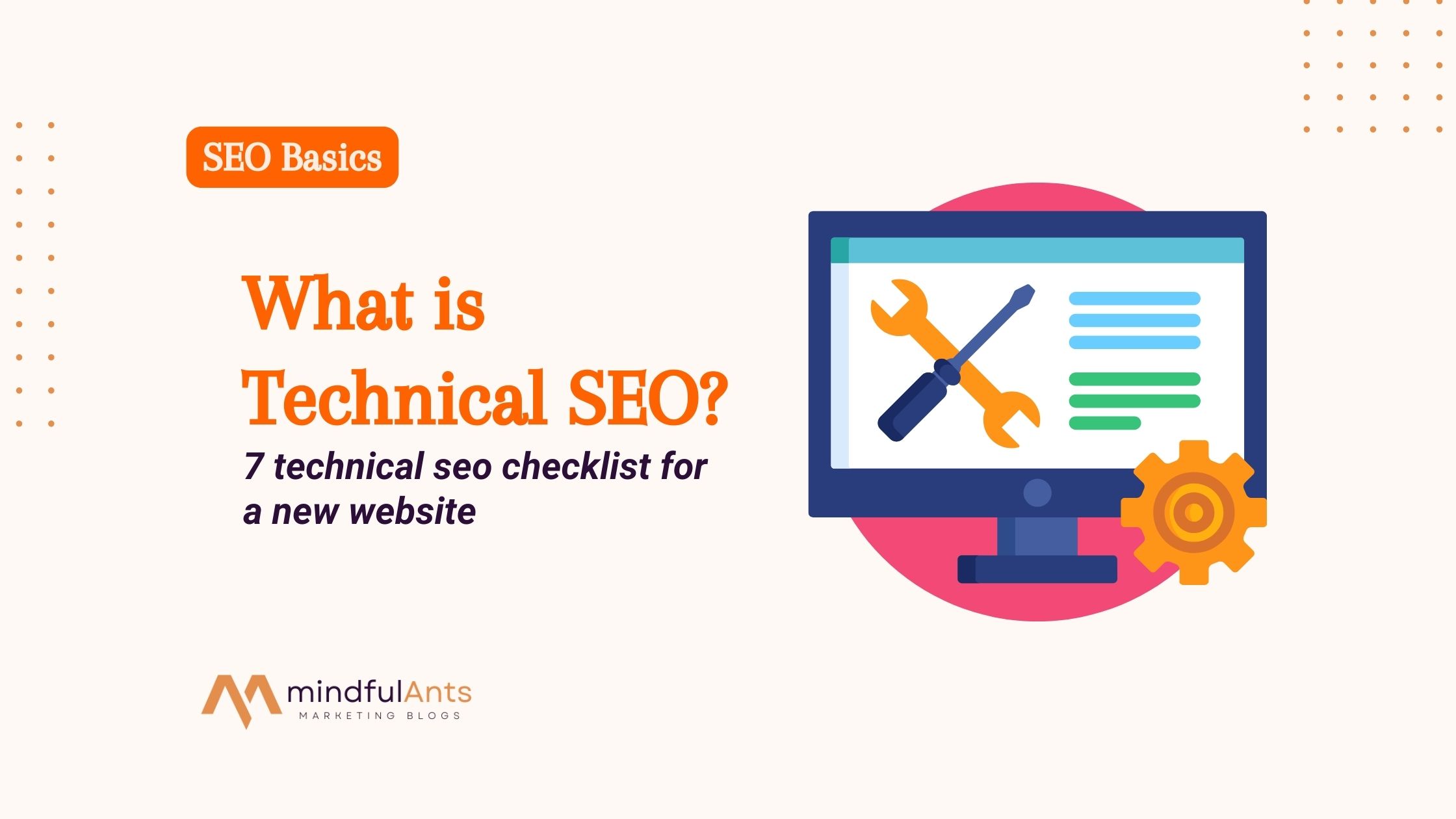Learning SEO terminology is a fundamental aspect of any organic marketing.
Why?
In today’s marketing era, most businesses are shifting toward online marketing, via websites, social media, etc, and if your small business is not optimized for it then you are missing out on potential clients. Therefore, it is important to tap into organic marketing.
In this blog, we will understand search optimization from the basic question “What is SEO” to 20+ SEO terminologies associated, that will help small businesses understand website optimization and set a baseline for organic marketing.
Let’s start with the basic question – what is SEO and what does Google say about SEO?

What is Search Engine Optimization (SEO)?
SEO stands for Search Engine Optimization. It is a practice of small changes to your website to gain higher visibility on SERP (Search engine results page).
Let’s understand with an example –
Suppose you are looking for information on – “how to make a cake” and the results shown in the SERP are the result of organic marketing, which is achieved when the content is optimized for search engines and users.

SEO, or Search Engine Optimization, is making certain changes to your website to gain visibility and rank higher on SERP for specific keywords or phrases, which can help attract potential customers online.
It is also a part of digital marketing that attracts users organically which means you don’t need to advertise additionally to gain customers.
SEO practice typically involves:
- Targeting the right keywords
- Content creation around the keywords and optimization
- Optimization of service/product pages with money keyword
- Checking the technical aspects of the website
- Checking the mobile compatibility of the website
- Acquiring quality backlinks
Common SEO Terminology:
| S.N | SEO Terms | Meaning of SEO Terminologies |
| 1 | Ranking | Position of a webpage in search engine results. |
| 2 | Organic Traffic | Visitors to a website from search engine results. |
| 3 | SERP | Search Engine Results Page displaying search results. |
| 4 | Inbound Links | Links from external sites pointing to a webpage. |
| 5 | Outbound Links | Links from a webpage to external sites. |
| 6 | Page Speed | Loading time of a specific webpage. |
| 7 | NoFollow Link | Hyperlink attribute instructing search engines not to follow. |
| 8 | DoFollow Link | Hyperlink attribute allowing search engines to follow. |
| 9 | Domain Authority (DA) | Metric predicting a website’s ranking potential. |
| 10 | Page Authority (PA) | Metric predicting an individual page’s ranking potential. |
Why Does SEO Matter?
In our daily lives, we use mobile, laptops, home computers, etc., to search online for groceries, shops, businesses, and more.
According to Similarweb, users visited Google 85.3 billion times monthly.`
So, this is why businesses need to have a strong online presence that can potentially reach customers who are actively searching for their products or services online.
Here are some of the key reasons why SEO is important:
- High search engine visibility for your brand or content
- Targeted organic traffic for specific search queries
- SEO builds credibility and trust
- It is more cost-effective than other forms of digital marketing
- User experience and mobile optimization
- SEO supports local search visibility
- SEO helps with voice search
Basic SEO Terminology You Need to Know
Search engine optimization is huge. SEO has different types and categories. To understand more effectively I have divided this into similar sections – types of SEO & categories of SEO.
Types of SEO
Based on the SEO practice and the use of techniques. SEO is divided into three main types:
1. Whitehat SEO: Whitehat SEO refers to ethical and legitimate optimization practices that comply with search engine guidelines.
2. Blackhat SEO: Blackhat SEO refers to aggressive and often unethical techniques to manipulate search engine rankings quickly.
3. Greyhat SEO: Greyhat SEO involves techniques that might not necessarily violate search engine guidelines outright but could be considered borderline or ethically questionable.
Categories of SEO
Three main categories of SEO can be classified as:
- On-page SEO: Optimizing individual web pages to rank higher in search engines through content, code, and user experience enhancements.
- Off-page SEO: Improving search engine rankings through external activities like link building, social media marketing, and influencer outreach.
- Technical SEO: Optimizing the technical aspects of a website for better search engine visibility, including factors like site speed, mobile-friendliness, and structured data markup.
Other subsets of SEO are as follows:
- Local SEO
- Mobile SEO
- Image SEO
- Video SEO
- Voice SEO
- E-commerce SEO
- International SEO
Let’s explore these SEO categories in detail and learn the SEO terminologies of associated with each of these SEO categories.
1. On-page SEO
On-page SEO refers to the changes you make to your website, which involves optimizing the content and elements within individual web pages to improve their search engine rankings.
Here are some of the key On-Page SEO elements:
- Keyword research
- Content optimization
- Internal linking
- Title tags and meta description
- Improving URL structure
- Headings
SEO Terminology of On-Page SEO:
| S.N | On-Page SEO Terms | Meaning of On-page SEO Terminologies |
| 1 | Keyword | Words or phrases used to find information online. |
| 2 | Meta Tags | HTML tags providing metadata about a webpage. |
| 3 | Alt Text | Descriptive text for images for accessibility. |
| 4 | Title Tag | HTML tag specifying the title of a webpage. |
| 5 | Meta Description | Brief summary of webpage content in HTML. |
| 6 | URL | Web address of a webpage. |
| 7 | Keyword Density | Proportion of keywords to total words on a webpage. |
| 8 | Anchor Text | Clickable text in a hyperlink. |
| 9 | Canonical URL | Preferred URL for a webpage, avoiding duplicates. |
| 10 | Duplicate Content | Content that appears on more than one webpage. |
| 11 | Internal Linking | Links from one webpage to another within the same site. |
| 12 | Keyword Stuffing | Overuse of keywords on a webpage to manipulate rankings. |
| 13 | Header Tags | HTML tags indicating headings on a webpage. |
| 14 | Internal Links | Hyperlinks pointing to other pages within the same site. |
| 15 | External Links | Hyperlinks pointing to pages on other websites. |
| 16 | LSI Keywords | Related keywords to a primary keyword. |
| 17 | Call-to-Action (CTA) | Prompt for users to take a specific action. |
2. Off-Page SEO
Off-page SEO technique refers to the activity that you do other than your website to improve its visibility and authority. The most common is “link building”, where you acquire quality backlinks to your website.
Here are some of the Off-page SEO techniques:
- Social media sharing
- Commenting and replying
- Getting brand mentions
- Opening a resourceful thread
- Blogging & guest posting
- Broken link
- Communication on different channels with potential customers
- Local listing
- Sharing quality infographics
SEO Terminology of Off-Page SEO:
| S.N | Off-Page SEO Terms | Meaning of Off-Page SEO Terminologies |
| 1 | Backlink | Link from another website to yours. |
| 2 | Link Building | Process of acquiring backlinks to improve SEO. |
| 3 | Anchor Text | Text used in hyperlinks to link to your website. |
| 4 | Link Juice | Value passed from one site to another through links. |
| 5 | Backlink Profile | Collection of all backlinks pointing to a website. |
| 6 | Link Relevance | Relevance of the linking page’s content to your site. |
| 7 | Link Quality | Trustworthiness and authority of the linking site. |
| 8 | Social Signals | Metrics related to social media activity around a site. |
| 9 | Brand Mentions | Instances where your brand is mentioned without a link. |
| 10 | Guest Blogging | Writing and publishing articles on other websites. |
| 11 | Directory Submission | Submitting your website to online directories. |
| 12 | Forum Participation | Engaging in discussions on forums and leaving links. |
| 13 | Influencer Outreach | Collaborating with influential individuals for backlinks. |
| 14 | Press Releases | Distributing news releases to media outlets and websites. |
| 15 | Article Submission | Submitting articles to article directories for backlinks. |
| 16 | Blog Commenting | Leaving comments on blogs with a link back to your site. |
| 17 | Social Bookmarking | Sharing content on social bookmarking sites for backlinks. |
| 18 | Video Marketing | Creating and sharing videos to attract backlinks. |
| 19 | Q&A Participation | Answering questions on platforms like Quora with links. |
| 20 | Broken Link Building | Finding broken links on other sites and suggesting yours. |
| 21 | Competitor Analysis | Analyzing competitor backlink profiles for opportunities. |
3. Technical SEO
Technical SEO refers to the optimization of a website’s technical aspects to improve its visibility and ranking in search engine results. It focuses on enhancing website infrastructure, performance, and accessibility for search engine crawlers and users.
Technical SEO involves tasks such as optimizing website speed, improving site architecture, fixing crawl errors, implementing structured data markup, optimizing URL structure, and ensuring mobile-friendliness.
Here are some of Tech SEO techniques:
- XML Sitemaps
- Robots.txt
- Broken links on the website
- Core web vitals
- SSL certification
- Canonical URLs
- Site structure
SEO Terminology of Tech SEO:
| S.N | Tech SEO Terms | Meaning of Tech SEO Terminologies |
| 1 | Technical SEO | Optimization of website infrastructure and server configuration for better search engine crawling and indexing. |
| 2 | XML Sitemap | File listing URLs of a website’s pages for search engines to crawl and index. |
| 3 | Robots.txt | Text file instructing search engine crawlers which pages or sections of a website to crawl or ignore. |
| 4 | Canonical Tags | HTML tags specifying the preferred version of a webpage to avoid duplicate content issues. |
| 5 | Structured Data | Markup added to web content providing context for search engines, enhancing visibility in search results. |
| 6 | Website Speed | Loading time of web pages, impacting user experience and search engine rankings. |
| 7 | Mobile Responsiveness | Website design adapting seamlessly to various screen sizes and devices, is crucial for mobile search rankings. |
| 8 | JavaScript SEO | Optimization techniques for JavaScript-powered websites to ensure content visibility to search engines. |
| 9 | Accelerated Mobile Pages (AMP) | Stripped-down HTML versions of web pages designed to load quickly on mobile devices, enhancing user experience. |
| 10 | HTTPS | Secure protocol encrypting data transmitted between a website and a user’s browser, positively impacting search rankings. |
| 11 | Schema Markup | Structured data format providing additional context to search engines about webpage content, enhancing rich snippets. |
| 12 | Page Speed Optimization | Techniques to improve website loading times, including image optimization, minification, and caching. |
| 13 | Mobile-Friendly Test | Evaluation tool to assess if a website is optimized for mobile devices, impacting mobile search rankings. |
| 14 | Render-Blocking Resources | CSS and JavaScript files delaying webpage rendering, affecting page speed and user experience. |
| 15 | Hreflang Tags | HTML tags indicating language and regional targeting for multilingual and multinational websites. |
| 16 | Pagination | Handling of multi-page content to ensure search engines correctly index and rank individual pages. |
| 17 | International Targeting | Configuration settings informing search engines about the target audience for multilingual and multinational websites. |
| 18 | Redirects | Forwarding users and search engines from one URL to another, preserving link equity and user experience. |
| 19 | URL Structure | Organization of URLs for clarity, relevance, and ease of navigation, impacting search engine crawling and user experience. |
A subset of SEO: Combination of On-Page, Off-Page & Tech SEO.
These categories are a subset of SEO as these fall under the three main categories of SEO: On-page SEO, Off-page SEO, and Technical SEO.
1. Local SEO
Businesses use local SEO techniques with a local presence. For example, a restaurant with a local place and a website will use local SEO techniques to improve search ranking while optimizing a website with local keywords and business details.
The most common local SEO technique is putting your business in Google listing or Yelp.
Here are some local SEO techniques :
- Acquiring Local reviews and ratings
- Share upcoming events
- Update any promotional offers
- Update about services
- Share business details such as name, live location, address, or phone number
SEO Terminology of Local SEO:
| S.N | Local SEO Terms | Meaning of Local SEO Terminologies |
| 1 | Google My Business | Google’s tool for managing business info in search. |
| 2 | NAP | Name, Address, Phone Number of a business. |
| 3 | Local Citations | Mentions of a business’s NAP on other websites. |
| 4 | Local Pack | Group of local business listings displayed in SERP. |
| 5 | Local Keywords | Search terms with local intent, e.g., “near me”. |
| 6 | Local Schema | Structured data markup for local business information. |
| 7 | Reviews | Customer feedback influencing local rankings. |
| 8 | Local Backlinks | Links from local websites pointing to a business site. |
| 9 | Geotargeting | Targeting content to specific geographic locations. |
| 10 | Local Directories | Online directories listing local businesses. |
2. Mobile SEO
Mobile SEO techniques refer to optimizing a website for mobile users. Users use mobile devices to search quite often, and search engine prioritizes websites that provide a seamless experience. Global Stats Counter says 55.7% of searches are done on mobile devices.
Here are some of the mobile SEO techniques:
- Improving webpages that load fast & properly
- Keeping visible text ratio
- Mobile-friendly layouts
- Friendly navigation
SEO Terminology of Mobile SEO:
| S.N | Mobile SEO Terms | Meaning of Mobile SEO Terminologies |
| 1 | Mobile-Friendly | Websites easily accessible and usable on mobile devices. |
| 2 | AMP (Accelerated Mobile Pages) | Framework for creating fast-loading mobile web pages. |
| 3 | Mobile Optimization | Adapting website content and design for mobile users. |
| 4 | Touchscreen Compatibility | Design elements optimized for touch-based interaction on mobile devices. |
| 5 | Mobile-first Indexing | Google’s practice of primarily using the mobile version of a website’s content for indexing and ranking. |
3. Image SEO
Image SEO techniques refer to optimizing images on your website for search engine ranking and user experience.
Some of the image SEO techniques are:
- Optimized file name of the image
- Write alt text of the image
- Proper image dimensions
- Low file size without losing the quality of the image
- Using a sitemap to index the image
- Write image captions
SEO Terminology of Image SEO:
| S.N | Image SEO Terms | Meaning of Image SEO Terminologies |
| 1 | Image Filename | Descriptive filename reflecting image content. |
| 2 | Alt Text | Text describing image content for accessibility. |
| 3 | Title Attribute | Optional attribute providing additional image info. |
| 4 | Image Size | Optimized size for faster loading and better user experience. |
| 5 | Image Format | Format choice affecting quality and file size. |
| 6 | Image Compression | Reducing file size without significant quality loss. |
| 7 | Image Captions | Text accompanying images for context and relevance. |
| 8 | Image Sitemap | Separate sitemap listing image URLs for indexing. |
| 9 | Image Lazy Loading | Loading images as they come into view to improve performance. |
4. Video SEO
Video SEO is a technique that is used to optimize videos to rank higher in SERPs for relevant keywords. Usually, video is published on YouTube, the largest video-sharing platform. But many businesses also add videos to their websites to rank.
Here are some video SEO techniques:
- Optimize the title & meta description of the page
- Make a video as the hero of the page
- Use structured data
- Lazy-load videos
- Add video XML sitemap
- Don’t add the same video multiple times on the webpage
SEO Terminology of Video SEO:
| S.N | Video SEO Terms | Meaning of Video SEO Terminologies |
| 1 | Video Title | The title of the video should be descriptive and include relevant keywords. |
| 2 | Video Description | Text describing the video content, including keywords and relevant information. |
| 3 | Video Tags | Keywords or phrases are added to videos to improve discoverability. |
| 4 | Video Filename | The name of the video file, should include keywords and be descriptive. |
| 5 | Video Transcript | Text version of the video’s audio content, useful for search engines to index. |
| 6 | Video Sitemap | Sitemap specifically for videos, listing video URLs for search engines. |
| 7 | Thumbnail Optimization | Choosing an eye-catching thumbnail to increase click-through rate. |
5. Voice SEO
Voice SEO is a technique to optimize content that can appear in voice search results. As of 2023, 4.2 billion voice assistants are in use. Combining your traditional SEO with the voice can benefit your website. Here are some voice search statistics to learn.
In voice SEO, common terms and phrases are used in the content for more accurate voice search results.
Here are some voice SEO techniques:
- Target question keywords
- Target long-tail keywords
- Use conventional language in your content
- Optimize local keywords (most people use voice assistant for navigational purposes)
- Create FAQs
SEO Terminology of Voice SEO:
| S.N | Voice SEO Terms | Meaning of Voice SEO Terminologies |
| 1 | Voice Search | Using spoken commands to search the internet. |
| 2 | Natural Language Processing (NLP) | AI understanding human language. |
| 3 | Long-Form Answers | Detailed responses to voice queries. |
| 4 | Voice Assistants | Platforms facilitating voice searches (e.g., Siri, Alexa). |
| 5 | Natural-sounding Text | Content resembling human speech patterns. |
| 6 | Contextual Content | Relevance to user context or situation. |
6. E-commerce SEO
E-commerce SEO term is specifically used for the optimization of online stores. Here, E-commerce SEO techniques are used to rank product pages and category pages to rank on SERP results. By optimizing product and category pages with relevant money keywords and technical SEO, a page is likely to rank on SERP.
Overall, structure, navigation, and smooth buying are essential to online stores.
Here are some E-commerce SEO techniques to work with:
- Research for specific and relevant keywords
- Create a structure for the website
- Write engaging and informative product descriptions
- Careful with URL structure
- Use image optimization (as products have images).
- Use breadcrumbs for easy navigation
- Add products to blogs where appropriate
SEO Terminology of E-Commerce SEO:
| S.N | E-Comm SEO Terms | Meaning of E-Comm SEO Terminologies |
| 1 | Product Descriptions | Writing unique, compelling descriptions with relevant keywords. |
| 2 | Category Structure | Creating a clear hierarchy for easy navigation and indexing. |
| 3 | User Reviews | Encouraging and showcasing user-generated content for credibility. |
| 4 | Conversion Rate Optimization (CRO) | Improving website conversion rates for better ROI. |
| 5 | FAQ Pages | Addressing common queries to improve user experience and SEO. |
7. International SEO
International SEO is a practice when you optimize your website to reach the desired country. For example, you want your website to rank in Germany. In that case, you will use International SEO techniques to reach an audience from Germany.
Here are some International SEO techniques that you can use:
- Use keywords between different regions
- Use the hreflang attribute to your website
- Link to local content
- Build backlinks from local sites
SEO Terminology of International SEO:
| S.N | Inter-SEO Terms | Meaning of Inter-SEO Terminologies |
| 1 | Hreflang Tag | HTML attribute indicating language and region targeting. |
| 2 | International SEO | Optimization strategies for targeting global audiences. |
| 3 | Geo-targeting | Tailoring content based on user location or region. |
| 4 | Multilingual SEO | Optimizing content for multiple languages. |
| 5 | Internationalization | Adapting a website for global audiences. |
| 6 | Language Targeting | Strategy focusing on specific language audiences. |
| 7 | IP Detection | Identifying user location through IP address. |
| 8 | International Hosting | Choosing servers located in target countries for SEO. |
Importance of SEO for Small and Local Businesses?
Having a strong online presence is vital for small and local businesses. Here’s why SEO (Search Engine Optimization) is essential:
- Increased Visibility: 93% of online experiences start with a search engine. SEO boosts your ranking, making it easier for customers to find you.
- Targeting Local Customers: 46% of Google searches are local. SEO helps you connect with nearby customers searching for your services.
- Building Trust: 75% of users don’t go past the first search page. Ranking high builds trust and credibility, leading to more clicks and sales.
- Cost-Effective Marketing: SEO is cheaper than traditional ads and reaches a targeted audience effectively.
- Beating Competition: SEO levels the playing field, ensuring your business stands out against competitors.
How to Measure SEO Campaigns?
For small businesses, measuring the effectiveness of SEO campaigns is essential to understand their impact and make informed decisions.
To measure such SEO campaigns there are various tools available in the market. But the most important tool for any marketer will be Google Analytics and Google Webmaster tools.
Why use this tool?
Both the tools are from Google and are freely available, as we all know that Google is the king of search engines. Google is the leading search engine worldwide, with 84% desktop market share.
Google Analytics Tool
It is a web analytics tool that collects your website data for marketing insights. GA4, the latest version, can collect your website and app data and connect with various tools. It is a top choice for customer insights. Check the tool here.
Here are some key Google Analytics metrics to track for your SEO marketing campaigns:
- Total Users
- Page Views
- Session
- Conversions
- Engagement Rate
- Event Count
- Sessions Per User
- Average Engagement Time
Google Webmaster Tool
It is a powerful tool to monitor your site’s visibility and issues. You can add XML sitemaps, check core web vitals reports, check internal and external links, and more. Check the tool here.
Here are some key Google webmaster metrics to track for your SEO marketing campaigns:
- Clicks
- Impressions
- Average CTR
- Average Position
- Page Indexation
Common SEO Problems Done by Small Businesses?
SEO is not a one-time thing; it needs to be regularly monitored and make changes accordingly. However, many small business owners make common mistakes while publishing new websites.
Here’s the following:
1. Keyword stuffing
Yes, that’s a thing. It’s a common SEO mistake many people make, using targeted keywords in every paragraph over using keywords on the titles and meta descriptions. This results in poor-quality content and is not beneficial for users.
2. Ignoring mobile optimization
Many new website owners publish their websites in a rush, ignoring mobile optimization. This may result in poor user experience, poor navigation, and content readability.
3. Using thin content
Yes, content is an important part of SEO. Still, many new website owners publish content in a rush with less word count and outdated facts and data.
4. Missing Internal link
Internal links are very important for ranking your web pages. Many site owners miss this opportunity to link content.
5. XML Sitemap
XML sitemap is important in SEO as this informs search engines which pages to crawl. Many site owners don’t create or forget to submit. Your website will still get indexed without an XML sitemap, but it helps search engines find your content easily.
6. Multiple H1 tags
Many new site owners use multiple H1 tags. Yes, using a well-optimized H1 tag is important, but using multiple on a single page is not one of them.
Importance of Knowing These Basic SEO Terminology
We all know that digital presence is very important in today’s market and understanding this SEO terminology will help us to understand what your project needs and how you can approach SEO.
SEO is very effective in the long run for many reasons, such as brand awareness, organic sales, and more.
Many micro and small business owners don’t implement SEO during development or early business stages, which can cost more in the future.
It is good to invest a little time and money in SEO and setting up SEO tools during the early stage of the website or while building an SEO-friendly website.
In the vastness of organic marketing, SEO terminology is like learning the language of the internet. It will help you to navigate the complexities of online organic marketing.
Let’s continue to explore SEO basics and apply this knowledge to shape the online presence and achieve growth.
Bonus: Importance of SEO basics for new website owners
Many business owners know digital presence is very important in today’s market. To achieve your goals, you come across many resources and techniques, such as SEO.
Although you can invest and hire a team of experts and do paid marketing to make sales, it is also good to know the basics of SEO. SEO is very effective in the long run for many reasons, such as brand awareness, organic sales, and more.
Many micro and small business owners don’t implement SEO during development or early business stages, which can cost more in the future. It is good to invest a little time in SEO during the early stage of the website.
If you find the blog useful, kindly😇. Do follow us on our social media channels. 👍🙏




